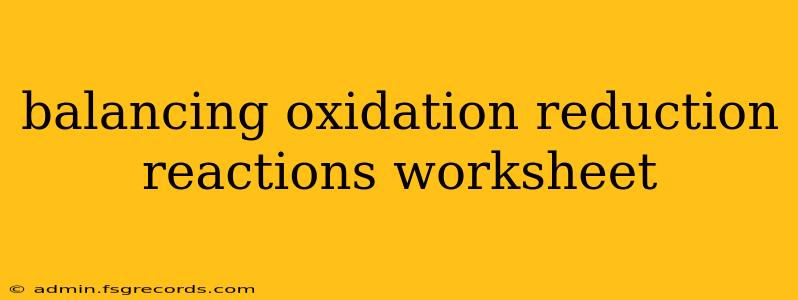Balancing redox reactions can seem daunting at first, but with a systematic approach, it becomes manageable. This guide will walk you through the process, providing clear explanations and examples to help you master this essential chemistry skill. We'll cover various methods, including the half-reaction method and the oxidation number method, ensuring you're well-equipped to tackle any redox balancing worksheet.
Understanding Oxidation and Reduction
Before we dive into balancing, let's refresh our understanding of the core concepts:
- Oxidation: The loss of electrons by an atom, ion, or molecule. The oxidation state (or oxidation number) of the species increases.
- Reduction: The gain of electrons by an atom, ion, or molecule. The oxidation state of the species decreases.
- Redox Reaction: A chemical reaction involving both oxidation and reduction processes. These reactions always occur simultaneously; you cannot have one without the other.
Key Concepts:
- Oxidation States: These represent the hypothetical charge an atom would have if all bonds were completely ionic. Assigning oxidation states is crucial for balancing redox reactions.
- Oxidizing Agent: The species that causes oxidation in another species (itself gets reduced).
- Reducing Agent: The species that causes reduction in another species (itself gets oxidized).
Method 1: The Half-Reaction Method
This method is particularly useful for reactions occurring in aqueous solutions. It involves separating the overall redox reaction into two half-reactions: one for oxidation and one for reduction.
Steps:
- Assign Oxidation States: Determine the oxidation state of each atom in the reactants and products.
- Write Half-Reactions: Separate the overall reaction into two half-reactions, one showing oxidation and the other showing reduction.
- Balance Atoms (Except O and H): Balance all atoms except oxygen and hydrogen in each half-reaction.
- Balance Oxygen: Add H₂O molecules to balance oxygen atoms.
- Balance Hydrogen: Add H⁺ ions to balance hydrogen atoms.
- Balance Charge: Add electrons (e⁻) to balance the charge in each half-reaction.
- Equalize Electrons: Multiply each half-reaction by a factor to make the number of electrons equal in both half-reactions.
- Add Half-Reactions: Add the two half-reactions together, canceling out electrons and any other common species.
- Simplify: Simplify the equation by canceling out any common terms on both sides.
- Verify: Double-check that the atoms and charges are balanced on both sides of the final equation.
Example:
Balance the following redox reaction in acidic solution:
Fe²⁺(aq) + MnO₄⁻(aq) → Fe³⁺(aq) + Mn²⁺(aq)
(Solution steps would be detailed here, showing each step outlined above with the specific numbers and equations for this example.)
Method 2: The Oxidation Number Method
This method is often simpler for reactions not in aqueous solution. It focuses directly on the changes in oxidation numbers.
Steps:
- Assign Oxidation States: Determine the oxidation state of each atom in the reactants and products.
- Identify Changes: Identify which atoms undergo changes in oxidation state.
- Determine Electron Transfer: Calculate the number of electrons transferred per atom undergoing a change in oxidation state.
- Balance Electron Transfer: Make the total number of electrons lost equal to the total number of electrons gained by multiplying the appropriate species.
- Balance Other Atoms: Balance the remaining atoms by inspection.
- Verify: Check that the atoms and charges are balanced.
Example:
Balance the following redox reaction:
K₂Cr₂O₇ + KI + H₂SO₄ → Cr₂(SO₄)₃ + K₂SO₄ + I₂ + H₂O
(Solution steps would be detailed here, showing each step outlined above with the specific numbers and equations for this example.)
Practice Problems
Now that you've learned the methods, try these practice problems to solidify your understanding:
(Include several practice problems of varying difficulty here, with space for students to work them out.)
Conclusion
Balancing redox reactions is a fundamental skill in chemistry. By mastering the half-reaction and oxidation number methods, you'll be well-prepared to tackle more complex chemical problems. Remember to practice regularly and consult additional resources if needed. Consistent effort will lead to success!

